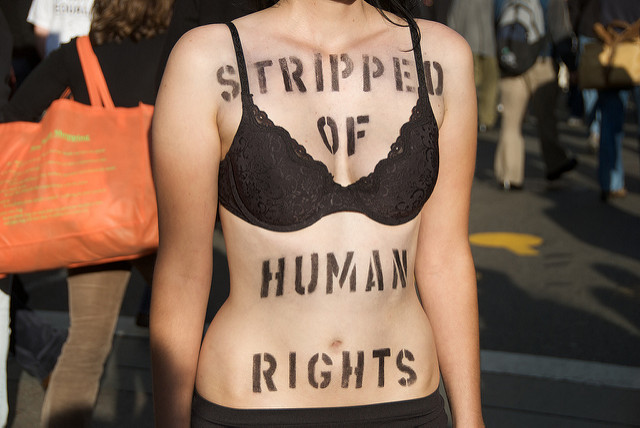Uncovering oneself in an action can garner a lot of media coverage and campaigns to reclaim body and sexual rights will be even more tempted than others to actually feature the object of the claim : the body and the sexualities.
Women’s movement have been at the forefront of this since the 60’s and up to today, with prominent anti-patriarchy group FEMEN or campaigns such as #FreeTheNipple campaign
There is even a specific global day for denouncing how women are expected to be perfect sex objects, and at the same time are pumped full of body shame from childhood. GoTopless Day always falls at the Sunday closest to Women’s Equality Day, Aug 26.
For LGBTQI+ people too, nudity is highly symbolic and LGBT groups have also used their bodies as a vehicle for expression, either to depict their oppression, as when the FEMEN protested in front of the Vatican in 2013, or their liberation, as is the case when naked bodies march in Pride parades. As a matter of fact, the recent crackdown of authorities on nudity during Pride marches has indeed been widely recognized as an attempt de de-politizice the LGBT liberation agenda.
For Trans organisations, the body is particularly both a vehicle for expression and an end in itself. The perfect example comes from a transgender US woman who in 2011 removed her top at the public authority which refused to alter the gender designation on her driver’s license from male to female, despite the fact that the U.S. federal government Social Security office already had. As it is legal for a man to go topless in public and since the Tennessee Department of Public Safety refused to recognise her as female, Ms Jones decided to protest her treatment by going topless, stating “if I was a male, I had the right to, when I stepped out the door, take off my shirt… It’s not right for the state to ask me to be both male and female. A choice needs to be made. They cannot hold me to both standards.”
But nudity can also be used as a vector for other messages. In which case, nudity is taken in its symbolic meaning.
A good example of nudity as a message is the animal welfare group PETA, whose activists strip to “go naked instead of wearing fur”.
The message is very clear: Be comfortable in your own skin so the animals can keep theirs!
Generally, being naked in the world today is associated with exposure — vulnerability to the elements as well as to other people’s desires. Every June, for instance, the World Naked Bike Ride expresses the extreme vulnerability of bicyclists in our car-addicted culture.
And when 600 Greenpeace protesters went without their clothes on a glacier in the Swiss Alps to highlight global warming, nudity served to depict warming.
Nudity is also an easy symbol for poverty. Students in Quebec took their fight against tuition increases and threat of future debt to the streets with naked marches to highlight their economic vulnerability.
Ways of making nudity a part of the message obviously depends on contexts, languages, etc. In English, the vocabulary around “being stripped of one’s rights” “exposing” or “the naked truth” allow many connections.
Nudity can also be used indirectly as part of a wider message. An interesting example is the HIV Shower selfie challenge, created by Housing Works.
The campaign is based around the idea that asking “are you clean?”, referring to HIV status, is offensive, and implies that anyone who is HIV positive is somehow “dirty”. The campaign invites people to take a photo of themselves in the shower using the hashtag ‘#weareALLclean’.
Nudity here serves its purpose of being an eye catcher and making the whole action nicely kinky without being provocative. Submissions were screened by the hosting website, to avoid offensive content and pornography. That is something to take into account, as it takes a lot of resources, especially if the campaign is very successful and you end up with hundreds of posts to go through and approve before they go up on your site.
Another creative campaign that uses the hint to sexuality is the UK #cockinasock campaign (Get Your Sock Out), an initiative working to raise awareness and funds for testicular and prostate cancer. After the first “cock in a sock” selfies were posted, the campaign went immediately viral worldwide, with national and international media coverage. The campaign succeeded in walking the thin line between provocation and humour.
Even when nudity is not part of the message, it creates one of the most powerful ways to attract attention. Straight allies stripping naked against homophobia is arguably one of the most potent ways of support, given that the underlying (or unconscious) assumption is that straight men should be afraid to be naked with gay men for fear of sexual abuse.
One very powerful initiative in this area is the initiative of the Nottingham (UK) Hockey Team which raised awareness for an anti-homophobia campaign by playing a hockey match – completely naked.

When nudity is not an option, either because of strict enforcement of decency laws, or because it would alienate parts of the public that the campaign aims to win over, it can still be used through suggestion, or through its sheer absence : Wrapping bodies up in symbols of women’s alienation to domestic work like wash-up sponges, is a way to use ‘nudity’ while not exposing a piece of flesh!
Clearly, nudity and hints to sexuality are in fashion, provided that the limits of decency are respected. These limits are obviously very dependent on collective cultural standards (remember the fuss Janet Jackson “Nipplegate”?) but also individual attitudes. Provoking your opponents (traditionally more conservative fringes of the public) while amusing your supporters is a double win, if done correctly.
Aware of the power of humour, and the attraction of young people to a more liberated version of sexuality, some conservative groups have lately been trying to also walk this line. In France, the opposition to same-sex marriage in 2013 was funded in large parts by the church, but was led by a rather provocative woman going with the very ‘second degree humor’ official pseudonym of ‘Frigid’. The demonstrations included slogans hostile to feminists like “give me sex, not gender”. Sexuality is clearly being used not only by “progressives”. A good analysis of how it has played out in national contexts, including how it has been used in advertisement, is absolutely necessary before engaging into action.
In any case, be mindful that most social media have a very strict nudity policy, and posting content deemed offensive can get your account to be suspended.
| COVID-19 update:
A group of German doctors have posed naked in an attempt to draw attention to shortages of protective clothing and equipment. Calling their protest Blanke Bedenken, or Naked Qualms, members of the group said they felt at risk from coronavirus and claimed their calls for help over several months had gone unheeded. In this case, nudity clearly served as a metaphor for fragility. The fact that patients are the ones who normally undress in front of doctors makes the opposite even more striking.
More information on this action HERE |
For more insights into nudity as a form of protest:
Wikipedia on nudity and protest
The Mirror: Naked protests: From topless bike rides to nude hikes and animal rights campaigns







